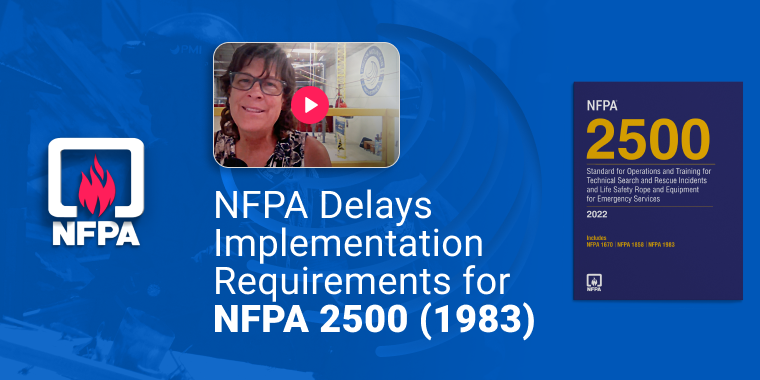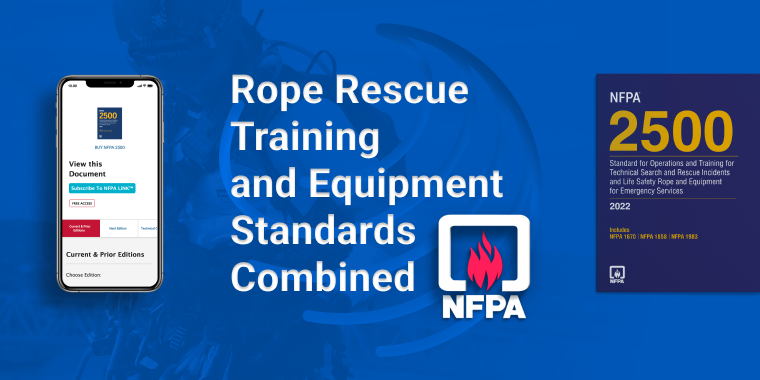Standards and Compliance
ANSI Z459.1 Rope Access and Two Connections to a Single Point
One of the MYTHS being generated about the new ANSI Z459.1 standard that was recently published as part of the ANSI Z359 Fall Protection Code is that this standard has introduced a prohibition on attaching TWO DESCENDERS to a SINGLE CONNECTION POINT on your harness.
Before addressing that particular question, let’s review the purpose of the ANSI Z459.1 standard. This document was recently developed under the auspices of the ANSI Z359 Fall Protection Code, an ANSI standard managed by the American Society of Safety Professionals as secretariat. The Z459.1 standard was more than 20 years in the making, and it’s purpose was to give credence and guidance to the use of rope access as a viable and acceptable form of work.
A typical rope access system includes a PROGRESS system and a BACKUP system. The PROGRESS SYSTEM might consist of a descender or an ascending system, while the BACKUP SYSTEM will be comprised of a rope grab of some sort, and whatever sort of lanyard or cow’s tail is intended to be used with it.
What specific components of equipment you use – brands and models – might vary – there are a score of descenders or ascenders that might be used as the Progress system, and any number of backup devices that might be used as backup – but the main concept remains that there is a PROGRESS system attached to your ventral, and a BACKUP system attached to your sternal.
THIS IS ROPE ACCESS.
This type of typical rope access system, with a progress system at the ventral and a backup system at sternal, is THE ONLY ONE that is addressed by the ANSI Z459.1 standard.
Employers (and their authorized technicians) may very well use other types of systems that are not typical rope access, but those are not addressed by this standard. For example, the ANSI Z459.1 standard does not address conventional fall arrest or restraint; it doesn’t address the use of netting systems; it doesn’t address that thing that people call RDS (Rope Descent Systems) – the ANSI Z459 standard just doesn’t address any of those things because they are not typical rope access systems.
In fact, there is a paragraph in the standard that clarifies exactly what type of system this rope access standard is addressing.
Paragraph 3.2.2 says that in order to be considered rope access under this standard
- there must always be two frontally attached systems in place,
- A progress system, and
- A Rope Access Safety Backup system
- And that in order to be considered rope access under this standard, the two must be interchangeable…
- In other words, the Progress System must be capable of being moved to the line hosting the Backup System, and vice-versa.
That’s what this standard considers to be rope access. If you are doing something else, the fact that it isn’t addressed by this standard does not invalidate it – it just means that it is not recognized as a typical ROPE ACCESS system by this standard.

Now, on a related note there appears to be some heartburn with another paragraph in this section that talks about NOT SIMULTANEOUSLY LOADING THE SAME ATTACHMENT POINT.
Here’s how that paragraph reads:
(Excerpted from ASSP/ANSI Z459.1)
3.2.2.2 The Rope Access Safety Backup System(s) and the Rope Access Progress System(s) shall be attached to the rope access technician’s harness in a manner that avoids both the progress system and the Rope Access Safety Backup system simultaneously loading the same attachment point.
NOTE: This is not to say that multiple attachments cannot be simultaneously made to the same attachment point. Especially during transitions, such as at a re-anchor or rope-to-rope transfer, simultaneous attachment to the same point on the harness is essential to prevent swing fall and protect the worker. the intent here is that the progress system and the Rope Access Safety Backup system should not be simultaneously loaded.
This paragraph may cause the reader to wonder… why does this paragraph even exist in the standard at all?
This paragraph was written specifically to address a couple of requirements that are actually found in OSHA Regulation.
Specifically in Part 29 of the Code of Federal Regulations, in the section on General Industry 1910.140 (c)(10) and in the section on Construction 1926.502 (d)(6) there are requirements that say that two CONNECTORS are not permitted to be attached to the same D-Ring at the same time. Now, to be clear, these are OSHA regulations that say this. OSHA, you may recall from an earlier post, carries the weight of law.
All ANSI can write are standards. OSHA is law, and ANSI can’t write standards that conflict with law.
With this in mind, OSHA’s statement that two connectors are not to be attached to the same D ring at the same time initially appeared to be a potential problem for rope access, because when we are doing changeovers for whatever reason, such as rope to rope transfers, typically we have FOUR systems attached at the same time – two progress systems at our waist and two backup systems at our sternal– to protect against swing fall as we move from one set of ropes to the other.
This is method is essential to the safety of rope access. But how could that practice co-exist with OSHA’s rules that say two connectors cannot be attached to the same D-Ring? Taken at face value, it would appear certain methods that are essential to rope access – particularly those involving changeovers and rope to rope transfers – would not be allowed at all under what the OSHA regulation SEEMED to say.
So the standards group conferred with regulatory representatives, fall protection engineers, and system designers to try to figure out what OSHA’s intent and concern was with this matter of connecting two connectors to a single point simultaneously. What they identified was a specific concern with compatibility and rollout. When you jam a bunch of things into one connection point, they can sometimes prevent each other from working properly. And, even if they do work, when you load any point from multiple directions simultaneously it can create greater stresses on that point, often in directions it was never intended to be loaded.

So the committee addressed these particular concerns in the Z459 standard by calling out compatibility, specifying in paragraph 5.3.1 that the manufacturer needs to address compatibility in product instructions, and then in paragraph 7.2.2 stating that Authorized Technicians must be knowledgeable on this topic.
The other concern that was identified had to do with redundancy. Many of the Fall Protection Experts that contributed to the process – including some regulators – asserted that the system is really not fully redundant if both the primary and secondary systems are simultaneously loading the same point.
Redundancy essentially can be defined as the idea that the failure of any one point will not result in catastrophic failure. And here, when you have both your primary and your secondary attached to the same point, failure of that connection point could conceivably result in catastrophic failure.
There’s kind of no getting around that one, OSHA says what they say and – regardless of how you or I might feel about it – it’s a thing.
In fact, it’s regulation, meaning it carries the weight of law.
Which pretty much compelled the consensus group that was writing the standard to meet the letter and intent of the OSHA regulation in terms of redundancy.
So the subcommittee worked within these parameters and provided that paragraph 3.2.2 (as excerpted above) to give context to the concerns identified from the larger body of fall protection experts, so that both users and regulators would be clear on the concept that it is actually OK to put two connectors into the same point, but that we are not to simultaneously load one point with primary and secondary systems.
If a technician were to do that, they would be out of context of the Z459 standard.
And, incidentally, perhaps more importantly, they would also be in violation of OSHA REGULATION, which is arguably an even greater concern.
Building on this concept, there is another concern that has been expressed by some rope access practitioners that is related to this concept. That is, the idea of Twin Tensioned Rope systems or Dual Tensioned systems or Mirrored Systems – people call them by different names but the premise here is that a system of access can be created by attaching TWO DESCENDERS to the SAME POINT on their harness, usually the ventral or waist attachment. The descenders are then operated in unison, each of the ropes taking more or less half the force.
This concept actually comes from the rescue world – this was a common technique used for rescue several decades ago or more – we would anchor a descender to a structural anchorage, then anchor another descender to the same structural anchorage, and we would operate both descenders simultaneously so that in effect one would serve as primary and the other as backup.
That system took a lot of flack and for a long time was considered BAD in rescue because there were arguments about whether or not it really provides redundancy – but then a few years ago someone realized that if just one of these systems DOES fail, there is less shock load on the other because it is already under tension, and maybe there’s something to that.
So this twin tensioned system came back into vogue in rescue, and now that is leaking over into rope access, but in this case the idea is that instead of connecting the descenders to an anchorage you connect them to your harness. The place that people are most promoting this dual rope system is for long drops – especially if you are using European semi-static or low stretch rope, because unless you are using truly static rope there can be an enormous amount of inherent stretch in a long system, so proponents of the twin tensioned system suggest that two descenders are easier to manage than a single descender with backup.
Now, at this time we will not discuss the efficacy or appropriateness or need for this type of system, we will simply focus on the assertion that the Z459.1 standard DISALLOWS this type of system.

Let’s go consider the beginning of this post, where we described a typical rope access system. The Twin Tension System just described is simply not a typical rope access system. Most rope access that employers engage in is of thetypical kind that we already talked about – with a primary system at the ventral attachment and a backup system on the sternal.
To reiterate: standard rope access is all that the ANSI Z459 standard addresses. It does not address Twin Tension systems at all, because Twin Tension systems are not a typical rope access system. They are unique, used for special circumstances. When you use them you have a whole different set of parameters or criteria in mind… just like when you use Conventional fall arrest, or restraint, or RDS, or fall arrest netting… the ANSI Z459 standard just doesn’t address any of THOSE either – because they are not typical rope access systems.
So, if you use any of those kinds of systems you would be working outside of what we consider to be typical of rope access, and different criteria and regulation would apply.
Which begs the question: in the absence of ANSI Standards, what regulation would apply to a Twin Tension System?
For that you would need to go back to an earlier post, about OSHA regulation. In that post we explained that OSHA has a catch-all category called FALL PROTECTION, and in that category there are some broad reaching requirements that apply to all fall protection, and then there are more specific criteria for individual systems like fall arrest, rope descent systems, restraint, and such.
So, theoretically, your Qualified Person COULD SPECIFY a system that is DIFFERENT from anything that is already addressed by ANSI or OSHA standards, as long as it follows those over-arching requirements that OSHA specifies for things like
- Impact force and deceleration requirements
- Autolocking connectors with 3600 pound gates
- Prohibition against simultaneous attachments to a single point
- Requirement for prompt rescue
Things like that.
Now to be clear – OSHA does allow for alternative procedures of compliance where an employer can prove that a different system will protect workers as well as or better than OSHA standards. If you want to delve more into that, you can look up Title 29 of the Code of Federal Regulations (CFR), Part 1905, Rules of Practice to learn about variances.
Hopefully, this post has helped to clear up at least this one point that has been misinterpreted by some regarding the ANSI Z459.1 standard. To summarize here specifically about this fallacy of ANSI Z459 prohibiting the use of two connectors to a single point:
- OSHA regulation has mandated for DECADES that two connectors are not permitted to be connected to a single point in ANY fall protection unless the equipment is specifically designed for that.
- ANSI Standards cannot be less stringent than OSHA regulation
- The paragraph found in ANSI Z459.1 about this was actually designed to provide clarification and ALLOWANCE for doing things like rope-to-rope transfers safely and efficiently while still maintaining compliance with the intended provision of the EXISTING OSHA REGULATION.
- Twin Tensioned Systems are NOT ADDRESSED by ANSI Z459.1 because they are not a TYPICAL rope access system.
- IF you want to use a Twin Tensioned system, your Qualified Person can address that in context of OSHA regulation.
If you are an employer or a regulator it is highly recommended that you get a copy of the standard yourself and READ IT to see how it can help you to provide greater safety in work at height. If you wish to have an official interpretation, you can reach out to the ANSI Z359 committee for that.
DISCLAIMER
This is not an official standards interpretation. This article is intended to offer perspective from the point of view of someone who participated in the development of the standard discussed. The author of this post has more than 35 years of experience in rope access and work at height, including having participated as a member of various standards committees and as chairman of the ANSI Z459.1 standard, and as founder of the Society of Professional Rope Access Technicians (SPRAT.)




0 comment